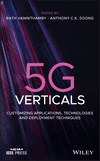Connected Aerials
Summary
To operate drones safely and to accomplish various missions, wireless technology is a critical component in control and command. This chapter discusses basic requirements and challenges for supporting drones over a cellular network. It provides a quick summary of drone regulations, which serves as a good indication of challenges in supporting drones and innovation in communications. The chapter reviews 3GPP Release 15 drone study and WIs – the first on drones in 3GPP. It provides a 5G drone support deep dive discussing challenges in supporting various drone uses, solutions from new technologies in 5G, and new studies needed for further 5G innovation toward future drone usages. Many drone applications, such as surveying, require 3D positioning support. Since cellular networks have always focused on serving terrestrial users and mostly use down-tilted base station antennas, aerial coverage and link qualities need to be carefully studied and optimized for drone support.
References
- Uber Elevate (2016). The future of urban mobility. https://www.uber.com/info/elevate (accessed 14 October 2019).
- 3GPP TS22.261 (2018). Service requirements for next generation new services and markets.
- 3GPP TR36.777 (2018). Enhanced LTE support for aerial vehicles.
- FAA (2018). Part 107. https://www.faa.gov/uas/media/Part_107_Summary.pdf (accessed 21 September 2018).
- China Civil Aviation Bureau (2015). Interim regulations on UAS.
- Qualcomm (2016). Qualcomm and AT&T trial drones on cellular network. https://www.qualcomm.com (accessed 14 October 2019).
- Qualcomm (2017). LTE unmanned aircraft systems, trial report v1.0.1, May 2017.
- Qualcomm (2016). Accelerating integration of drone into the cellular network. FCC TAC Meeting, August 2016.
- Qualcomm (2018). Leading the world to 5G: Evolving cellular technologies for safer drone operation. https://www.qualcomm.com/documents/leading-world-5g-evolving-cellular-technologies-safer-drone-operation (accessed 26 September 2018).
- Donovan, J. (2018). Drones taking our network to new heights. http://about.att.com/innovationblog/drones_new_heights (accessed 26 September 2018).
- The GSMA (2018). Mobile-enabled unmanned aircraft: How mobile networks can support unmanned aircraft operations.
- Cellular Telecommunications and Internet Association (2017). Commercial wireless networks: the essential foundation of the drone industry.
- Civil Aviation Administration of China (2018). Low-altitude connected drone flight safety test report, January 2018.
- NTT, Docomo, Ericsson (2017). 3GPP RP-170779 Study on Enhanced Support for Aerial Vehicles, March 2017.
- Ericsson (2017). RP-172826 New WID on Enhanced LTE Support for Aerial Vehicles, December 2017.
- ECC (2018). PT1 Meeting #59, Edinburgh.
- FAA (2019). Programs, Partnerships & Opportunities. https://www.faa.gov/uas/programs_partnerships (accessed 14 October 2019).
- NASA (2015). NASA UTM. https://utm.arc.nasa.gov (accessed 21 September 2018).
- US FAA and Department of Transportation (2018). UAS Integration Pilot Program. https://www.faa.gov/uas/programs_partnerships/uas_integration_pilot_program (accessed 28 September 2018.
- Gupta, L., Jain, R., and Vaszkun, G. (2016). Survey of important issues in UAV communication networks. IEEE Communication Surveys and Tutorials 18: 1123–1152.
-
Van den Bergh, B., Vermeulen, T., and Pollin, S. (2015). Analysis of harmful interference to and from aerial IEEE 802.11 systems. Proceedings of the First Workshop on Micro Aerial Vehicle Networks, Systems, and Applications for Civilian Use, DroNet'15, New York, NY, USA, pp. 15–19. ACM.
10.1145/2750675.2750685 Google Scholar
- Asadpour, M., Van den Bergh, B., Giustiniano, D. et al. (2014). Micro aerial vehicle networks: an experimental analysis of challenges and opportunities. IEEE Communications Magazine 52: 141–149.
- Cheng, C., Hsiao, P., Kung, H.T. et al. (2006). Performance measurement of 802.11a wireless links from UAV to ground nodes with various antenna orientations. Proceedings of the 15th International Conference on Computer Communications and Networks, pp. 303–308.
- Hayat, S., Yanmaz, E., and Muzaffar, R. (2016). Survey on unmanned aerial vehicle networks for civil applications: a communications viewpointe. IEEE Communication Surveys and Tutorials 18: 2624–2661.
- Ahmed, N., Kanhere, S.S., and Jha, S. (2016). On the importance of link characterization for aerial wireless sensor networks. IEEE Communications Magazine 54: 52–57.
- Andre, T., Hummel, K.A., Schoellig, A.P. et al. (2014). Application-driven design of aerial communication networks. IEEE Communications Magazine 52: 129–137.
- Bergh, B.V.D., Chiumento, A., and Pollin, S. (2016). LTE in the sky: trading off propagation benefits with interference costs for aerial nodes. IEEE Communications Magazine 54: 44–50.
- Teng, E., Falcao, D., Dominguez, C. et al. (2015). Aerial sensing and characterization of three-dimensional RF fields. Second International Workshop on Robotic Sensor Networks, Seattle, USA.
- Mozaffari, M., Saad, W., Bennis, M. et al. (2018). A tutorial on UAVs for wireless networks: Applications, challenges, and open problems, CoRR, vol. abs/1803.00680.
- 3GPP TR22.891 (2016). Study on new services and markets technology enablers.
- 3GPP TR22.862 (2016). Feasibility study on new services and markets technology enablers for critical communications.
- 3GPP TR38.811 (2018). Study on New Radio (NR) to support non-terrestrial networks.
- 3GPP TR22.825 (2018). Study on remote identification of Unmanned Aerial Systems (UAS).
- Lin, X., Yajnanarayana, V., Muruganathan, S.M. et al. (2018). The sky is not the limit: LTE for unmanned aerial vehicles. IEEE Communications Magazine 56: 204–210.
- 3GPP TR38.901 (2018). Study on channel model for frequencies from 0.5 to 100 GHz.
- Shafi, M., Molisch, A.F., Smith, P.J. et al. (2017). 5g: a tutorial overview of standards, trials, challenges, deployment, and practice. IEEE Journal on Selected Areas in Communications 35: 1201–1221.



